CORP2165 Contemporary Management: Leadership Principles and Styles
VerifiedAdded on 2022/08/17
|9
|2802
|15
Essay
AI Summary
This essay examines the links and differences between leadership and management, emphasizing the importance of leadership principles in supporting organizational values and the impact of leadership styles on achieving organizational objectives. It discusses leadership principles such as customer obsession and learning/curiosity, illustrating how they support organizational values like customer satisfaction and sustainability, using Amazon as a case study. Furthermore, the essay explores strategic and transactional leadership styles, highlighting their roles in enhancing coordination, promoting employee motivation, and achieving organizational goals. The analysis emphasizes how these leadership approaches enable companies like Amazon to adapt to competitive environments and prioritize customer needs effectively. The document is contributed by a student and published on Desklib, a platform offering AI-based study tools and a repository of academic resources for students.
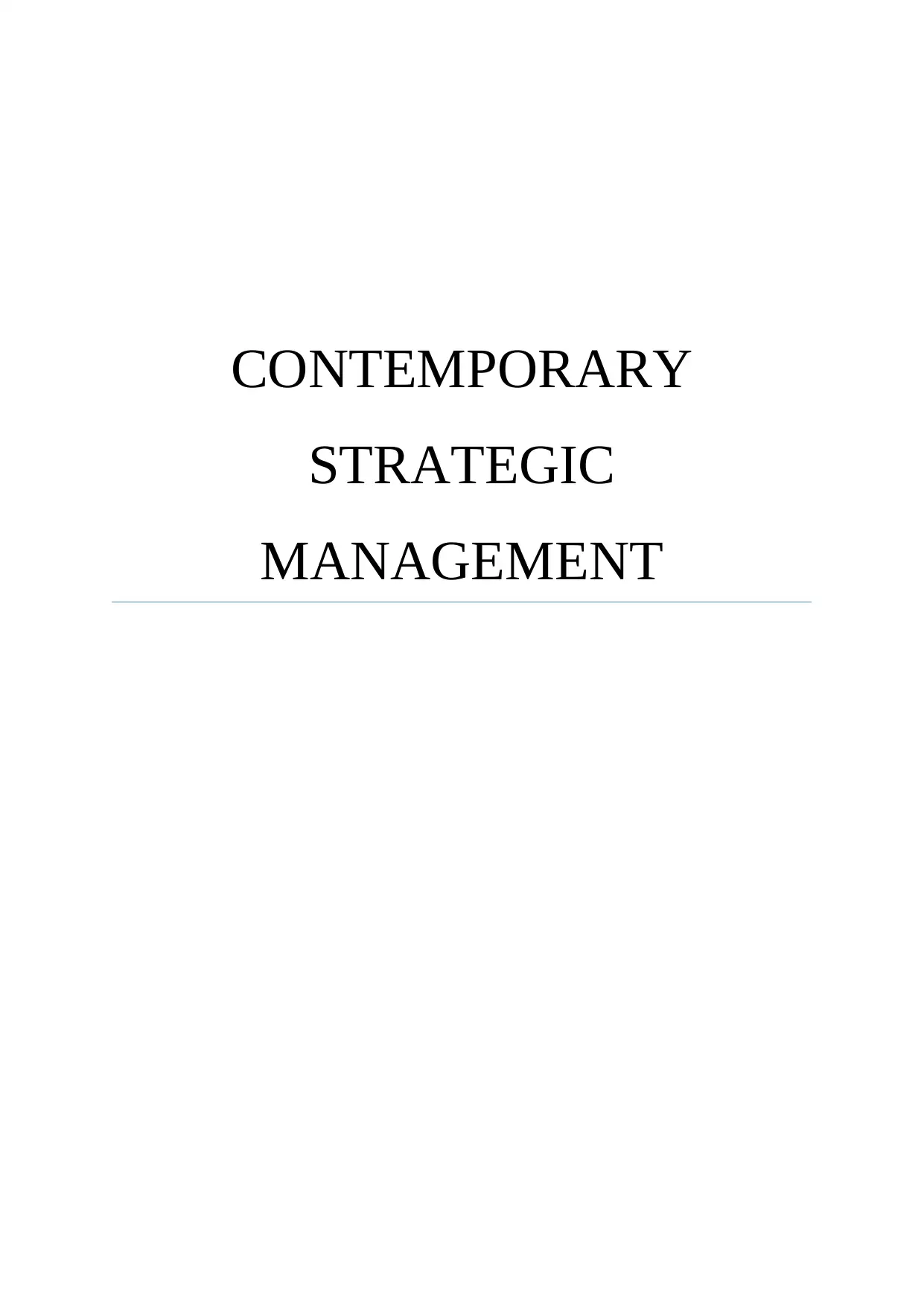
CONTEMPORARY
STRATEGIC
MANAGEMENT
STRATEGIC
MANAGEMENT
Secure Best Marks with AI Grader
Need help grading? Try our AI Grader for instant feedback on your assignments.
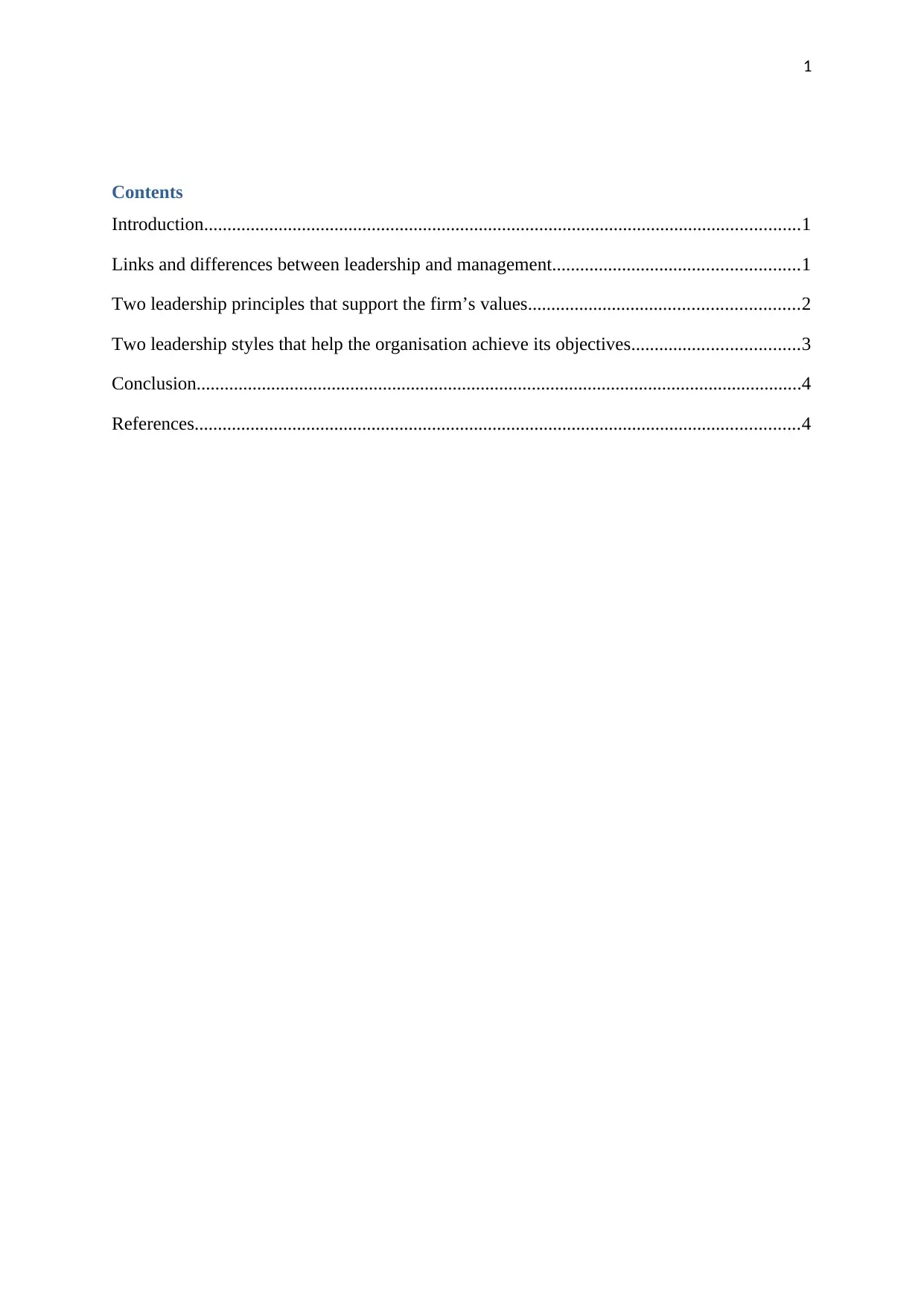
1
Contents
Introduction................................................................................................................................1
Links and differences between leadership and management.....................................................1
Two leadership principles that support the firm’s values..........................................................2
Two leadership styles that help the organisation achieve its objectives....................................3
Conclusion..................................................................................................................................4
References..................................................................................................................................4
Contents
Introduction................................................................................................................................1
Links and differences between leadership and management.....................................................1
Two leadership principles that support the firm’s values..........................................................2
Two leadership styles that help the organisation achieve its objectives....................................3
Conclusion..................................................................................................................................4
References..................................................................................................................................4
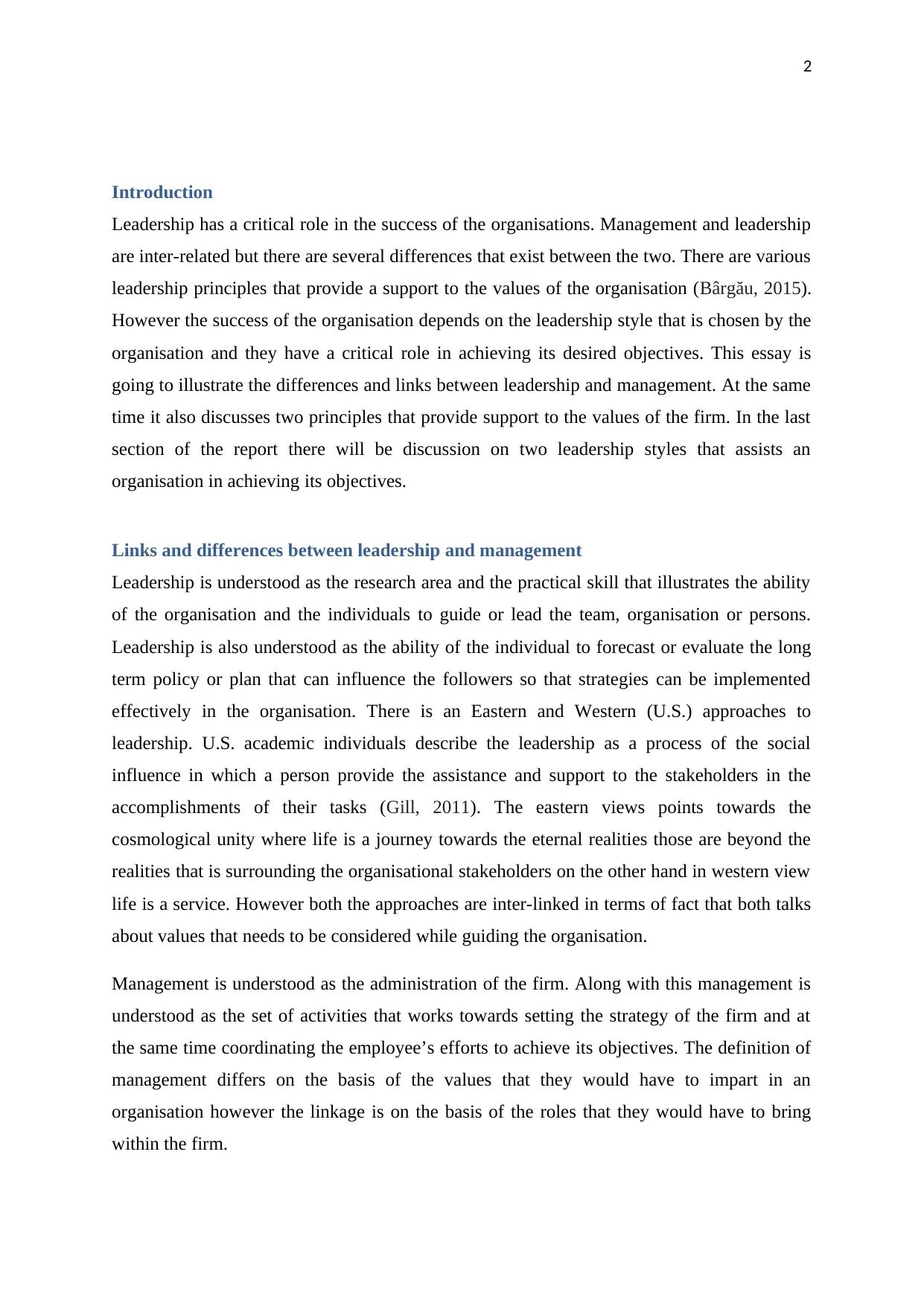
2
Introduction
Leadership has a critical role in the success of the organisations. Management and leadership
are inter-related but there are several differences that exist between the two. There are various
leadership principles that provide a support to the values of the organisation (Bârgău, 2015).
However the success of the organisation depends on the leadership style that is chosen by the
organisation and they have a critical role in achieving its desired objectives. This essay is
going to illustrate the differences and links between leadership and management. At the same
time it also discusses two principles that provide support to the values of the firm. In the last
section of the report there will be discussion on two leadership styles that assists an
organisation in achieving its objectives.
Links and differences between leadership and management
Leadership is understood as the research area and the practical skill that illustrates the ability
of the organisation and the individuals to guide or lead the team, organisation or persons.
Leadership is also understood as the ability of the individual to forecast or evaluate the long
term policy or plan that can influence the followers so that strategies can be implemented
effectively in the organisation. There is an Eastern and Western (U.S.) approaches to
leadership. U.S. academic individuals describe the leadership as a process of the social
influence in which a person provide the assistance and support to the stakeholders in the
accomplishments of their tasks (Gill, 2011). The eastern views points towards the
cosmological unity where life is a journey towards the eternal realities those are beyond the
realities that is surrounding the organisational stakeholders on the other hand in western view
life is a service. However both the approaches are inter-linked in terms of fact that both talks
about values that needs to be considered while guiding the organisation.
Management is understood as the administration of the firm. Along with this management is
understood as the set of activities that works towards setting the strategy of the firm and at
the same time coordinating the employee’s efforts to achieve its objectives. The definition of
management differs on the basis of the values that they would have to impart in an
organisation however the linkage is on the basis of the roles that they would have to bring
within the firm.
Introduction
Leadership has a critical role in the success of the organisations. Management and leadership
are inter-related but there are several differences that exist between the two. There are various
leadership principles that provide a support to the values of the organisation (Bârgău, 2015).
However the success of the organisation depends on the leadership style that is chosen by the
organisation and they have a critical role in achieving its desired objectives. This essay is
going to illustrate the differences and links between leadership and management. At the same
time it also discusses two principles that provide support to the values of the firm. In the last
section of the report there will be discussion on two leadership styles that assists an
organisation in achieving its objectives.
Links and differences between leadership and management
Leadership is understood as the research area and the practical skill that illustrates the ability
of the organisation and the individuals to guide or lead the team, organisation or persons.
Leadership is also understood as the ability of the individual to forecast or evaluate the long
term policy or plan that can influence the followers so that strategies can be implemented
effectively in the organisation. There is an Eastern and Western (U.S.) approaches to
leadership. U.S. academic individuals describe the leadership as a process of the social
influence in which a person provide the assistance and support to the stakeholders in the
accomplishments of their tasks (Gill, 2011). The eastern views points towards the
cosmological unity where life is a journey towards the eternal realities those are beyond the
realities that is surrounding the organisational stakeholders on the other hand in western view
life is a service. However both the approaches are inter-linked in terms of fact that both talks
about values that needs to be considered while guiding the organisation.
Management is understood as the administration of the firm. Along with this management is
understood as the set of activities that works towards setting the strategy of the firm and at
the same time coordinating the employee’s efforts to achieve its objectives. The definition of
management differs on the basis of the values that they would have to impart in an
organisation however the linkage is on the basis of the roles that they would have to bring
within the firm.

3
There are differences between Leadership and management. For instance leadership has the
role to develop strategies for the company but on the other hand management has the role to
manage the operations in such a manner that it supports the strategies made by the companies
and achieve the desired strategies. Leadership also has significant role in developing vision
and inspiring people while the management focuses on setting, achieving and measuring the
goals that can control the situations to achieve the desired objectives. Managers give direction
while the leaders ask questions. Leaders initiate for changes while managers react to such
kinds of changes and works with their team to accomplish this (Sullivan and Garland, 2010).
However there are certain similarities between leaders and managers. They both have the role
to ensure that they are ready for the challenges and guide their subordinates to achieve
specific requirements on time. Leadership and management are similar in terms of their role
to implement strategies and policies in an appropriate manner. Both are similar in terms of
reacting towards the challenges in a better manner. Leaders and managers are also similar in
terms of the people management skills that they need to have (Dalton, 2010).
Amazon believes in improving the leadership mechanism by building new leadership skills
among the employees. This is not only critical for the management of the operations but it is
also necessary for reducing conflicts within the organisation. Amazon follows the western
leadership approaches. This can be seen with the example of the fact that leadership promotes
the benefits of the organisations by providing support to the stakeholders in accomplishment
of the task.
Two leadership principles that support the firm’s values
There are different kinds of leadership principles that are being used by any leader. It is
critical for the leaders to tackle all the challenges that are faced by the firm. In this regards
the values of the organisations plays a critical role. Stacey, (2012) believes that leadership
principle allows an organisation to seek the path in which they aim to move so as to fulfil
their today’s requirement and also the requirement of their future. The organisational
principles like motivation allow an organisation to perform better. The principles such as hire
and develop the best allow an organisation to work as per the objectives of the organisation.
Algahtani, (2014) suggests that leadership principle such as thinking big allows a firm to look
on the larger picture and develop idea that can ensure the growth of the organisation.
There are differences between Leadership and management. For instance leadership has the
role to develop strategies for the company but on the other hand management has the role to
manage the operations in such a manner that it supports the strategies made by the companies
and achieve the desired strategies. Leadership also has significant role in developing vision
and inspiring people while the management focuses on setting, achieving and measuring the
goals that can control the situations to achieve the desired objectives. Managers give direction
while the leaders ask questions. Leaders initiate for changes while managers react to such
kinds of changes and works with their team to accomplish this (Sullivan and Garland, 2010).
However there are certain similarities between leaders and managers. They both have the role
to ensure that they are ready for the challenges and guide their subordinates to achieve
specific requirements on time. Leadership and management are similar in terms of their role
to implement strategies and policies in an appropriate manner. Both are similar in terms of
reacting towards the challenges in a better manner. Leaders and managers are also similar in
terms of the people management skills that they need to have (Dalton, 2010).
Amazon believes in improving the leadership mechanism by building new leadership skills
among the employees. This is not only critical for the management of the operations but it is
also necessary for reducing conflicts within the organisation. Amazon follows the western
leadership approaches. This can be seen with the example of the fact that leadership promotes
the benefits of the organisations by providing support to the stakeholders in accomplishment
of the task.
Two leadership principles that support the firm’s values
There are different kinds of leadership principles that are being used by any leader. It is
critical for the leaders to tackle all the challenges that are faced by the firm. In this regards
the values of the organisations plays a critical role. Stacey, (2012) believes that leadership
principle allows an organisation to seek the path in which they aim to move so as to fulfil
their today’s requirement and also the requirement of their future. The organisational
principles like motivation allow an organisation to perform better. The principles such as hire
and develop the best allow an organisation to work as per the objectives of the organisation.
Algahtani, (2014) suggests that leadership principle such as thinking big allows a firm to look
on the larger picture and develop idea that can ensure the growth of the organisation.
Secure Best Marks with AI Grader
Need help grading? Try our AI Grader for instant feedback on your assignments.
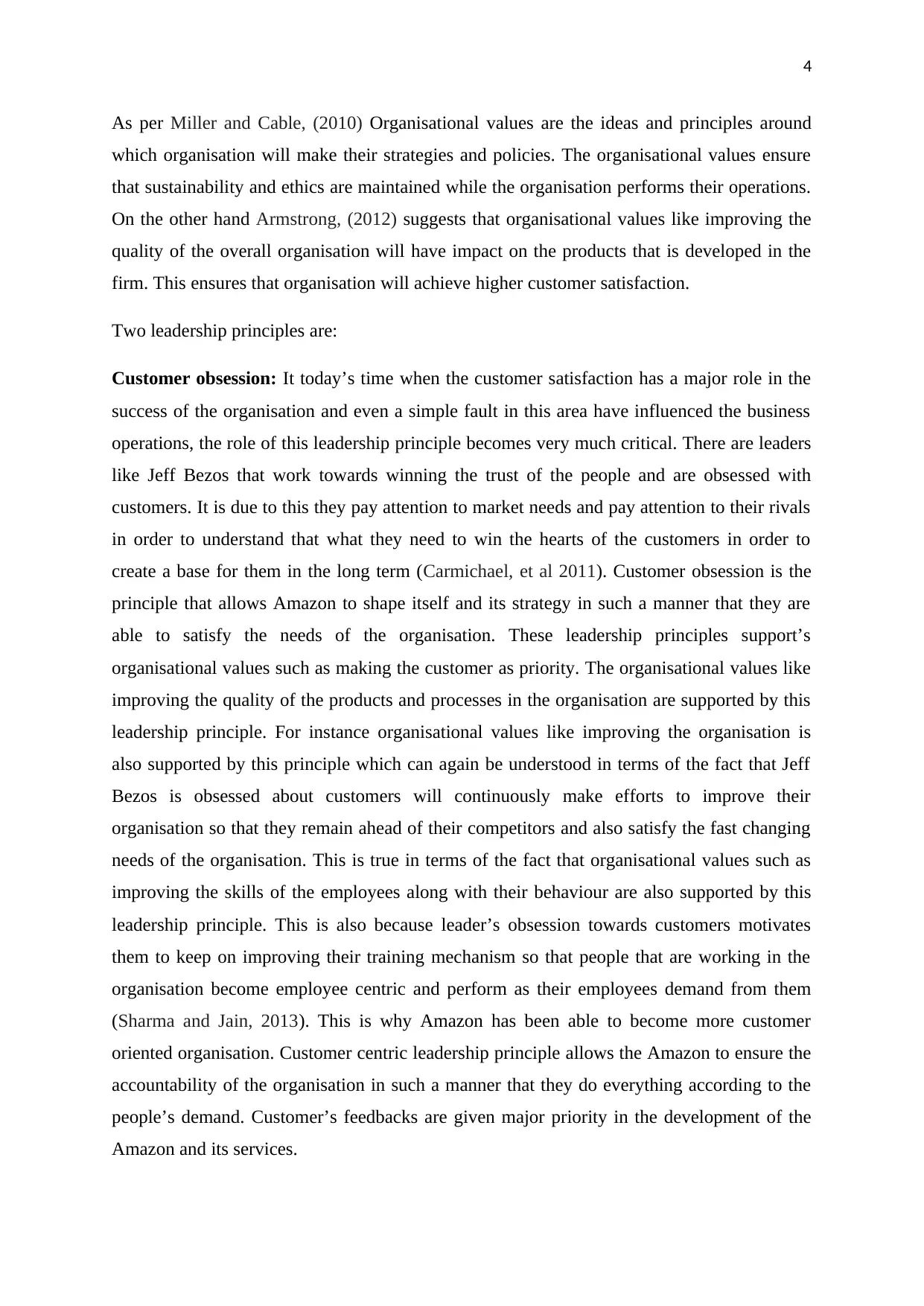
4
As per Miller and Cable, (2010) Organisational values are the ideas and principles around
which organisation will make their strategies and policies. The organisational values ensure
that sustainability and ethics are maintained while the organisation performs their operations.
On the other hand Armstrong, (2012) suggests that organisational values like improving the
quality of the overall organisation will have impact on the products that is developed in the
firm. This ensures that organisation will achieve higher customer satisfaction.
Two leadership principles are:
Customer obsession: It today’s time when the customer satisfaction has a major role in the
success of the organisation and even a simple fault in this area have influenced the business
operations, the role of this leadership principle becomes very much critical. There are leaders
like Jeff Bezos that work towards winning the trust of the people and are obsessed with
customers. It is due to this they pay attention to market needs and pay attention to their rivals
in order to understand that what they need to win the hearts of the customers in order to
create a base for them in the long term (Carmichael, et al 2011). Customer obsession is the
principle that allows Amazon to shape itself and its strategy in such a manner that they are
able to satisfy the needs of the organisation. These leadership principles support’s
organisational values such as making the customer as priority. The organisational values like
improving the quality of the products and processes in the organisation are supported by this
leadership principle. For instance organisational values like improving the organisation is
also supported by this principle which can again be understood in terms of the fact that Jeff
Bezos is obsessed about customers will continuously make efforts to improve their
organisation so that they remain ahead of their competitors and also satisfy the fast changing
needs of the organisation. This is true in terms of the fact that organisational values such as
improving the skills of the employees along with their behaviour are also supported by this
leadership principle. This is also because leader’s obsession towards customers motivates
them to keep on improving their training mechanism so that people that are working in the
organisation become employee centric and perform as their employees demand from them
(Sharma and Jain, 2013). This is why Amazon has been able to become more customer
oriented organisation. Customer centric leadership principle allows the Amazon to ensure the
accountability of the organisation in such a manner that they do everything according to the
people’s demand. Customer’s feedbacks are given major priority in the development of the
Amazon and its services.
As per Miller and Cable, (2010) Organisational values are the ideas and principles around
which organisation will make their strategies and policies. The organisational values ensure
that sustainability and ethics are maintained while the organisation performs their operations.
On the other hand Armstrong, (2012) suggests that organisational values like improving the
quality of the overall organisation will have impact on the products that is developed in the
firm. This ensures that organisation will achieve higher customer satisfaction.
Two leadership principles are:
Customer obsession: It today’s time when the customer satisfaction has a major role in the
success of the organisation and even a simple fault in this area have influenced the business
operations, the role of this leadership principle becomes very much critical. There are leaders
like Jeff Bezos that work towards winning the trust of the people and are obsessed with
customers. It is due to this they pay attention to market needs and pay attention to their rivals
in order to understand that what they need to win the hearts of the customers in order to
create a base for them in the long term (Carmichael, et al 2011). Customer obsession is the
principle that allows Amazon to shape itself and its strategy in such a manner that they are
able to satisfy the needs of the organisation. These leadership principles support’s
organisational values such as making the customer as priority. The organisational values like
improving the quality of the products and processes in the organisation are supported by this
leadership principle. For instance organisational values like improving the organisation is
also supported by this principle which can again be understood in terms of the fact that Jeff
Bezos is obsessed about customers will continuously make efforts to improve their
organisation so that they remain ahead of their competitors and also satisfy the fast changing
needs of the organisation. This is true in terms of the fact that organisational values such as
improving the skills of the employees along with their behaviour are also supported by this
leadership principle. This is also because leader’s obsession towards customers motivates
them to keep on improving their training mechanism so that people that are working in the
organisation become employee centric and perform as their employees demand from them
(Sharma and Jain, 2013). This is why Amazon has been able to become more customer
oriented organisation. Customer centric leadership principle allows the Amazon to ensure the
accountability of the organisation in such a manner that they do everything according to the
people’s demand. Customer’s feedbacks are given major priority in the development of the
Amazon and its services.
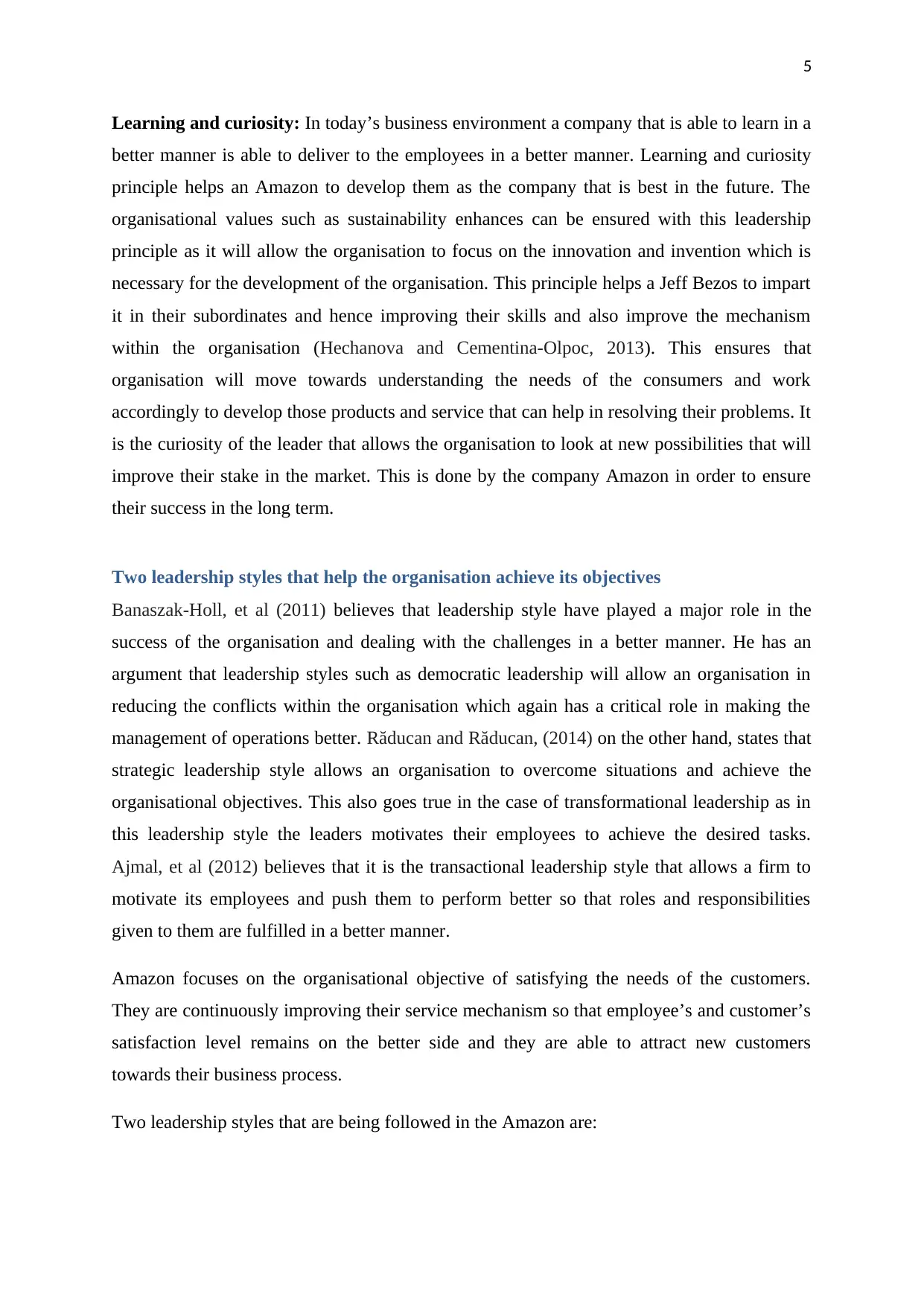
5
Learning and curiosity: In today’s business environment a company that is able to learn in a
better manner is able to deliver to the employees in a better manner. Learning and curiosity
principle helps an Amazon to develop them as the company that is best in the future. The
organisational values such as sustainability enhances can be ensured with this leadership
principle as it will allow the organisation to focus on the innovation and invention which is
necessary for the development of the organisation. This principle helps a Jeff Bezos to impart
it in their subordinates and hence improving their skills and also improve the mechanism
within the organisation (Hechanova and Cementina-Olpoc, 2013). This ensures that
organisation will move towards understanding the needs of the consumers and work
accordingly to develop those products and service that can help in resolving their problems. It
is the curiosity of the leader that allows the organisation to look at new possibilities that will
improve their stake in the market. This is done by the company Amazon in order to ensure
their success in the long term.
Two leadership styles that help the organisation achieve its objectives
Banaszak-Holl, et al (2011) believes that leadership style have played a major role in the
success of the organisation and dealing with the challenges in a better manner. He has an
argument that leadership styles such as democratic leadership will allow an organisation in
reducing the conflicts within the organisation which again has a critical role in making the
management of operations better. Răducan and Răducan, (2014) on the other hand, states that
strategic leadership style allows an organisation to overcome situations and achieve the
organisational objectives. This also goes true in the case of transformational leadership as in
this leadership style the leaders motivates their employees to achieve the desired tasks.
Ajmal, et al (2012) believes that it is the transactional leadership style that allows a firm to
motivate its employees and push them to perform better so that roles and responsibilities
given to them are fulfilled in a better manner.
Amazon focuses on the organisational objective of satisfying the needs of the customers.
They are continuously improving their service mechanism so that employee’s and customer’s
satisfaction level remains on the better side and they are able to attract new customers
towards their business process.
Two leadership styles that are being followed in the Amazon are:
Learning and curiosity: In today’s business environment a company that is able to learn in a
better manner is able to deliver to the employees in a better manner. Learning and curiosity
principle helps an Amazon to develop them as the company that is best in the future. The
organisational values such as sustainability enhances can be ensured with this leadership
principle as it will allow the organisation to focus on the innovation and invention which is
necessary for the development of the organisation. This principle helps a Jeff Bezos to impart
it in their subordinates and hence improving their skills and also improve the mechanism
within the organisation (Hechanova and Cementina-Olpoc, 2013). This ensures that
organisation will move towards understanding the needs of the consumers and work
accordingly to develop those products and service that can help in resolving their problems. It
is the curiosity of the leader that allows the organisation to look at new possibilities that will
improve their stake in the market. This is done by the company Amazon in order to ensure
their success in the long term.
Two leadership styles that help the organisation achieve its objectives
Banaszak-Holl, et al (2011) believes that leadership style have played a major role in the
success of the organisation and dealing with the challenges in a better manner. He has an
argument that leadership styles such as democratic leadership will allow an organisation in
reducing the conflicts within the organisation which again has a critical role in making the
management of operations better. Răducan and Răducan, (2014) on the other hand, states that
strategic leadership style allows an organisation to overcome situations and achieve the
organisational objectives. This also goes true in the case of transformational leadership as in
this leadership style the leaders motivates their employees to achieve the desired tasks.
Ajmal, et al (2012) believes that it is the transactional leadership style that allows a firm to
motivate its employees and push them to perform better so that roles and responsibilities
given to them are fulfilled in a better manner.
Amazon focuses on the organisational objective of satisfying the needs of the customers.
They are continuously improving their service mechanism so that employee’s and customer’s
satisfaction level remains on the better side and they are able to attract new customers
towards their business process.
Two leadership styles that are being followed in the Amazon are:
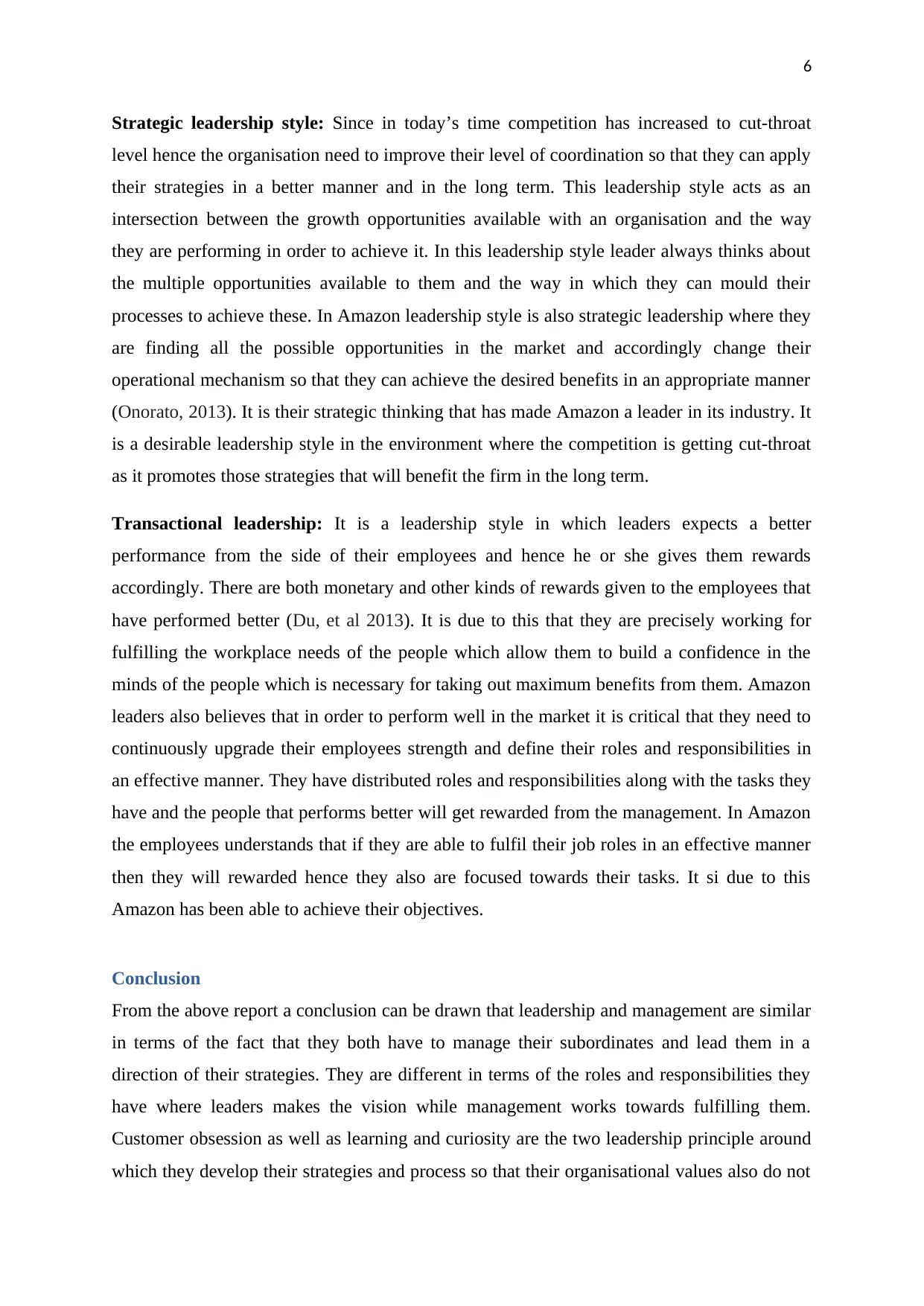
6
Strategic leadership style: Since in today’s time competition has increased to cut-throat
level hence the organisation need to improve their level of coordination so that they can apply
their strategies in a better manner and in the long term. This leadership style acts as an
intersection between the growth opportunities available with an organisation and the way
they are performing in order to achieve it. In this leadership style leader always thinks about
the multiple opportunities available to them and the way in which they can mould their
processes to achieve these. In Amazon leadership style is also strategic leadership where they
are finding all the possible opportunities in the market and accordingly change their
operational mechanism so that they can achieve the desired benefits in an appropriate manner
(Onorato, 2013). It is their strategic thinking that has made Amazon a leader in its industry. It
is a desirable leadership style in the environment where the competition is getting cut-throat
as it promotes those strategies that will benefit the firm in the long term.
Transactional leadership: It is a leadership style in which leaders expects a better
performance from the side of their employees and hence he or she gives them rewards
accordingly. There are both monetary and other kinds of rewards given to the employees that
have performed better (Du, et al 2013). It is due to this that they are precisely working for
fulfilling the workplace needs of the people which allow them to build a confidence in the
minds of the people which is necessary for taking out maximum benefits from them. Amazon
leaders also believes that in order to perform well in the market it is critical that they need to
continuously upgrade their employees strength and define their roles and responsibilities in
an effective manner. They have distributed roles and responsibilities along with the tasks they
have and the people that performs better will get rewarded from the management. In Amazon
the employees understands that if they are able to fulfil their job roles in an effective manner
then they will rewarded hence they also are focused towards their tasks. It si due to this
Amazon has been able to achieve their objectives.
Conclusion
From the above report a conclusion can be drawn that leadership and management are similar
in terms of the fact that they both have to manage their subordinates and lead them in a
direction of their strategies. They are different in terms of the roles and responsibilities they
have where leaders makes the vision while management works towards fulfilling them.
Customer obsession as well as learning and curiosity are the two leadership principle around
which they develop their strategies and process so that their organisational values also do not
Strategic leadership style: Since in today’s time competition has increased to cut-throat
level hence the organisation need to improve their level of coordination so that they can apply
their strategies in a better manner and in the long term. This leadership style acts as an
intersection between the growth opportunities available with an organisation and the way
they are performing in order to achieve it. In this leadership style leader always thinks about
the multiple opportunities available to them and the way in which they can mould their
processes to achieve these. In Amazon leadership style is also strategic leadership where they
are finding all the possible opportunities in the market and accordingly change their
operational mechanism so that they can achieve the desired benefits in an appropriate manner
(Onorato, 2013). It is their strategic thinking that has made Amazon a leader in its industry. It
is a desirable leadership style in the environment where the competition is getting cut-throat
as it promotes those strategies that will benefit the firm in the long term.
Transactional leadership: It is a leadership style in which leaders expects a better
performance from the side of their employees and hence he or she gives them rewards
accordingly. There are both monetary and other kinds of rewards given to the employees that
have performed better (Du, et al 2013). It is due to this that they are precisely working for
fulfilling the workplace needs of the people which allow them to build a confidence in the
minds of the people which is necessary for taking out maximum benefits from them. Amazon
leaders also believes that in order to perform well in the market it is critical that they need to
continuously upgrade their employees strength and define their roles and responsibilities in
an effective manner. They have distributed roles and responsibilities along with the tasks they
have and the people that performs better will get rewarded from the management. In Amazon
the employees understands that if they are able to fulfil their job roles in an effective manner
then they will rewarded hence they also are focused towards their tasks. It si due to this
Amazon has been able to achieve their objectives.
Conclusion
From the above report a conclusion can be drawn that leadership and management are similar
in terms of the fact that they both have to manage their subordinates and lead them in a
direction of their strategies. They are different in terms of the roles and responsibilities they
have where leaders makes the vision while management works towards fulfilling them.
Customer obsession as well as learning and curiosity are the two leadership principle around
which they develop their strategies and process so that their organisational values also do not
Paraphrase This Document
Need a fresh take? Get an instant paraphrase of this document with our AI Paraphraser
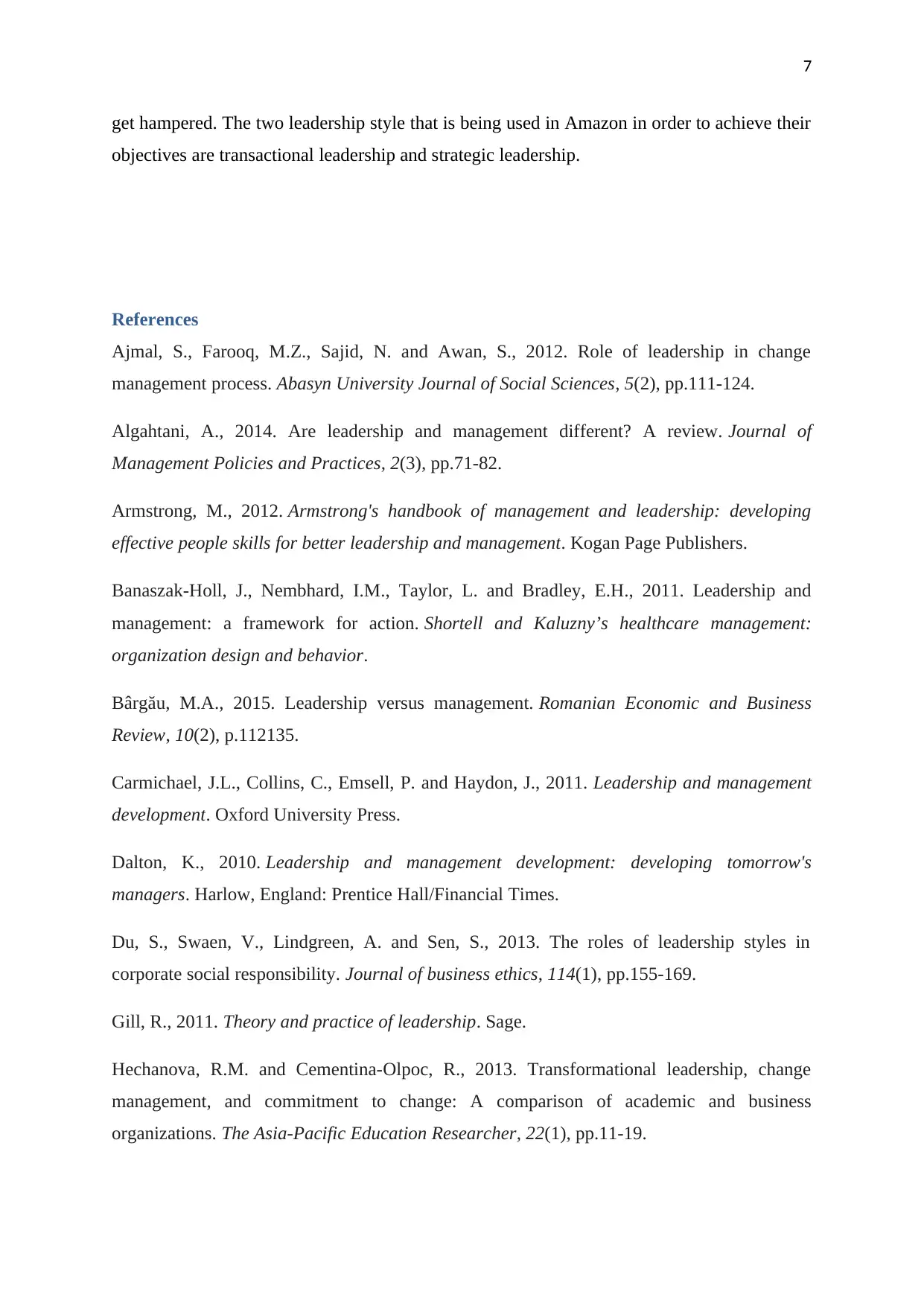
7
get hampered. The two leadership style that is being used in Amazon in order to achieve their
objectives are transactional leadership and strategic leadership.
References
Ajmal, S., Farooq, M.Z., Sajid, N. and Awan, S., 2012. Role of leadership in change
management process. Abasyn University Journal of Social Sciences, 5(2), pp.111-124.
Algahtani, A., 2014. Are leadership and management different? A review. Journal of
Management Policies and Practices, 2(3), pp.71-82.
Armstrong, M., 2012. Armstrong's handbook of management and leadership: developing
effective people skills for better leadership and management. Kogan Page Publishers.
Banaszak-Holl, J., Nembhard, I.M., Taylor, L. and Bradley, E.H., 2011. Leadership and
management: a framework for action. Shortell and Kaluzny’s healthcare management:
organization design and behavior.
Bârgău, M.A., 2015. Leadership versus management. Romanian Economic and Business
Review, 10(2), p.112135.
Carmichael, J.L., Collins, C., Emsell, P. and Haydon, J., 2011. Leadership and management
development. Oxford University Press.
Dalton, K., 2010. Leadership and management development: developing tomorrow's
managers. Harlow, England: Prentice Hall/Financial Times.
Du, S., Swaen, V., Lindgreen, A. and Sen, S., 2013. The roles of leadership styles in
corporate social responsibility. Journal of business ethics, 114(1), pp.155-169.
Gill, R., 2011. Theory and practice of leadership. Sage.
Hechanova, R.M. and Cementina-Olpoc, R., 2013. Transformational leadership, change
management, and commitment to change: A comparison of academic and business
organizations. The Asia-Pacific Education Researcher, 22(1), pp.11-19.
get hampered. The two leadership style that is being used in Amazon in order to achieve their
objectives are transactional leadership and strategic leadership.
References
Ajmal, S., Farooq, M.Z., Sajid, N. and Awan, S., 2012. Role of leadership in change
management process. Abasyn University Journal of Social Sciences, 5(2), pp.111-124.
Algahtani, A., 2014. Are leadership and management different? A review. Journal of
Management Policies and Practices, 2(3), pp.71-82.
Armstrong, M., 2012. Armstrong's handbook of management and leadership: developing
effective people skills for better leadership and management. Kogan Page Publishers.
Banaszak-Holl, J., Nembhard, I.M., Taylor, L. and Bradley, E.H., 2011. Leadership and
management: a framework for action. Shortell and Kaluzny’s healthcare management:
organization design and behavior.
Bârgău, M.A., 2015. Leadership versus management. Romanian Economic and Business
Review, 10(2), p.112135.
Carmichael, J.L., Collins, C., Emsell, P. and Haydon, J., 2011. Leadership and management
development. Oxford University Press.
Dalton, K., 2010. Leadership and management development: developing tomorrow's
managers. Harlow, England: Prentice Hall/Financial Times.
Du, S., Swaen, V., Lindgreen, A. and Sen, S., 2013. The roles of leadership styles in
corporate social responsibility. Journal of business ethics, 114(1), pp.155-169.
Gill, R., 2011. Theory and practice of leadership. Sage.
Hechanova, R.M. and Cementina-Olpoc, R., 2013. Transformational leadership, change
management, and commitment to change: A comparison of academic and business
organizations. The Asia-Pacific Education Researcher, 22(1), pp.11-19.
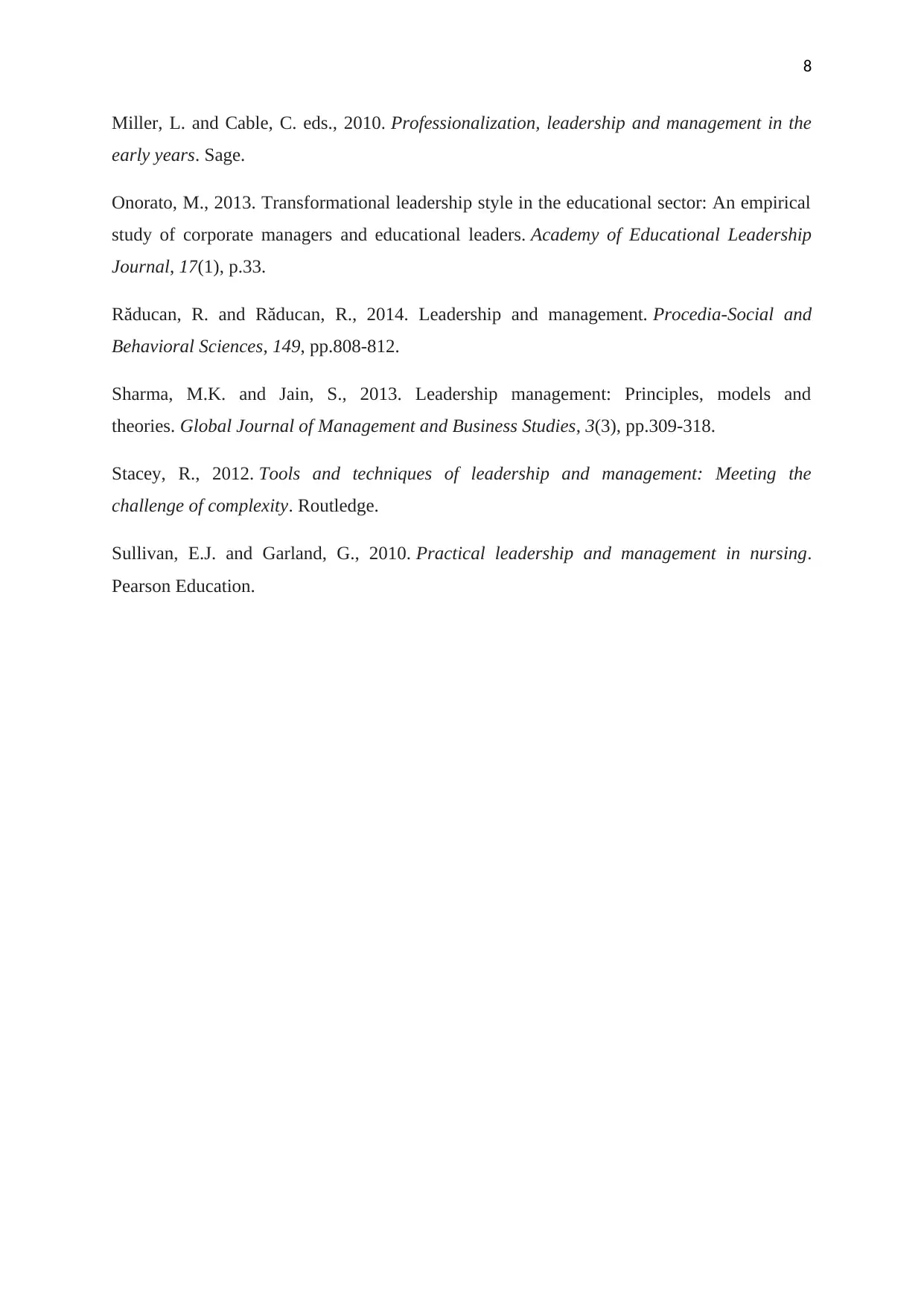
8
Miller, L. and Cable, C. eds., 2010. Professionalization, leadership and management in the
early years. Sage.
Onorato, M., 2013. Transformational leadership style in the educational sector: An empirical
study of corporate managers and educational leaders. Academy of Educational Leadership
Journal, 17(1), p.33.
Răducan, R. and Răducan, R., 2014. Leadership and management. Procedia-Social and
Behavioral Sciences, 149, pp.808-812.
Sharma, M.K. and Jain, S., 2013. Leadership management: Principles, models and
theories. Global Journal of Management and Business Studies, 3(3), pp.309-318.
Stacey, R., 2012. Tools and techniques of leadership and management: Meeting the
challenge of complexity. Routledge.
Sullivan, E.J. and Garland, G., 2010. Practical leadership and management in nursing.
Pearson Education.
Miller, L. and Cable, C. eds., 2010. Professionalization, leadership and management in the
early years. Sage.
Onorato, M., 2013. Transformational leadership style in the educational sector: An empirical
study of corporate managers and educational leaders. Academy of Educational Leadership
Journal, 17(1), p.33.
Răducan, R. and Răducan, R., 2014. Leadership and management. Procedia-Social and
Behavioral Sciences, 149, pp.808-812.
Sharma, M.K. and Jain, S., 2013. Leadership management: Principles, models and
theories. Global Journal of Management and Business Studies, 3(3), pp.309-318.
Stacey, R., 2012. Tools and techniques of leadership and management: Meeting the
challenge of complexity. Routledge.
Sullivan, E.J. and Garland, G., 2010. Practical leadership and management in nursing.
Pearson Education.
1 out of 9
Related Documents
Your All-in-One AI-Powered Toolkit for Academic Success.
+13062052269
info@desklib.com
Available 24*7 on WhatsApp / Email
![[object Object]](/_next/static/media/star-bottom.7253800d.svg)
Unlock your academic potential
© 2024 | Zucol Services PVT LTD | All rights reserved.





